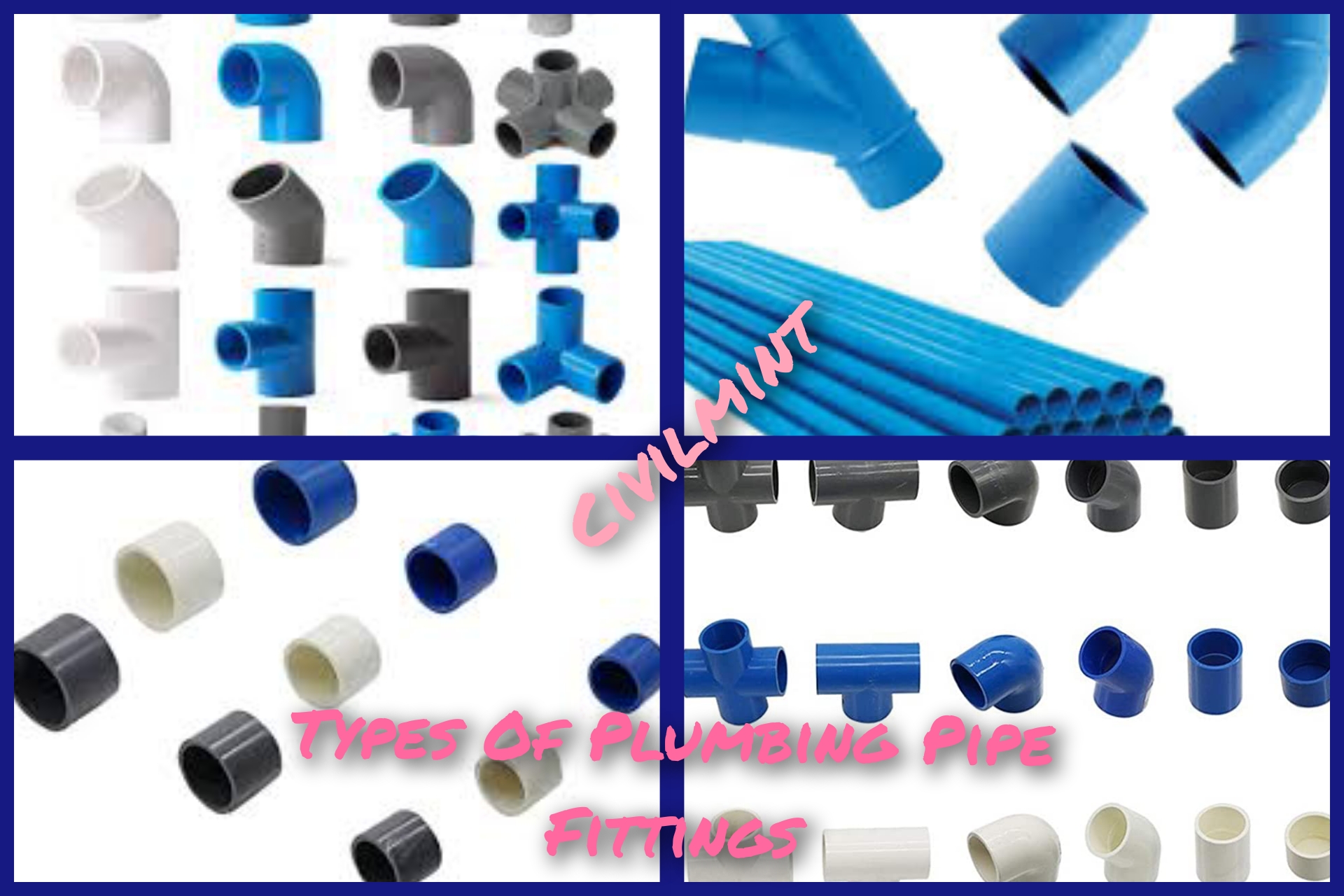There are different types of plumbing fittings used in plumbing piping systems. We will discuss all types of plumbing fittings.

Table of Contents
Different Types Of Plumbing Pipe Fittings
1. Ball Valve:
A type of valve that uses a ball-shaped disk to control the flow of a fluid through a pipeline. When the valve is open, the ball rotates so that the fluid can flow through, and when it’s closed, the ball blocks the flow.
I also advise you to read my detailed article on ball valve.
2. Check Valve:
A valve that allows fluid to flow in only one direction. It typically uses a spring or weight to keep the valve closed when there’s no flow, and opens when fluid is flowing in the right direction.
You can also read my article on check valve.
3. Chlorinated Polyvinyl Chloride (CPVC) Fittings:
A thermoplastic material that’s similar to PVC but has improved temperature and chemical resistance properties. It’s often used for hot water piping systems and industrial applications.
4. Closet Flange:
A pipe fitting that’s used to connect a toilet to a drainpipe. It’s typically made of PVC or ABS plastic and is secured to the floor with screws or bolts.
5. Compression Fitting:
A type of pipe fitting that uses a compression ring (or ferrule) to create a seal between the fitting and the pipe. It’s commonly used for connecting pipes that carry gas or water.
6. Concentric Reducer:
A type of fitting that’s used to connect two pipes of different sizes. It has a conical shape and is typically used when the larger pipe needs to be reduced in size.
7. Coupling (Full and Half):
A pipe fitting that’s used to join two pipes together. A full coupling connects two pipes of the same size, while a half coupling connects to a threaded connection.
8. Diverter Tee:
A type of tee fitting that’s used to divert the flow of fluid in a pipeline. It has a straight-through section and two branch sections that are angled.
9. Eccentric Reducer:
A type of fitting that’s similar to a concentric reducer but has an off-center connection. It’s typically used to avoid trapping air or sediment in the pipeline.
10. Flange:
A type of pipe fitting that’s used to connect two pipes together. It typically consists of a circular plate with holes for bolts or screws that secure it to the pipe.
11. Flare Fitting:
A type of pipe fitting that’s used to connect metal pipes together. It has a conical shape and is typically used in applications where high pressure is required.
12. National Pipe Thread (NPT):
A standard thread used for pipes and fittings in the United States. It’s a tapered thread that creates a seal between the fitting and the pipe.
13. Needle Valve:
A type of valve that’s used to control the flow of fluid in a pipeline. It has a needle-shaped disk that can be adjusted to vary the size of the flow opening.
14. PEX:
A flexible plastic material that’s used for piping in plumbing systems. It’s easy to install and has good resistance to chemicals and temperature changes.
15. Pipe Flanges:
A type of pipe fitting that’s used to connect two pipes together. It typically consists of a circular plate with holes for bolts or screws that secure it to the pipe.
16. Polyvinyl Chloride (PVC):
A thermoplastic material that’s commonly used for piping in plumbing systems. It’s lightweight, durable, and resistant to chemicals.
17. Reducer:
A type of fitting that’s used to connect two pipes of different sizes. It has a conical shape and is typically used when the larger pipe needs to be reduced in size.
18. Sleeve:
A type of pipe fitting that’s used to connect two pipes together. It typically consists of a cylindrical tube that fits over the ends of the pipes and is secured in place with clamps or screws.
19. Street Elbow:
A type of elbow fitting that’s used to connect pipes at a 90-degree angle. It has a male end and a female end, allowing it to connect to a threaded pipe fitting.
20. Tee Type Pipe Fitting:
A type of pipe fitting that’s used to connect three pipes together. It has a T-shaped design, with one straight-through section and two branch sections.
21. Trade Union:
A type of pipe fitting that’s used to connect two pipes together in a way that allows them to be easily disconnected. It typically consists of two halves that are connected with a threaded nut.
22. Trap:
A type of pipe fitting that’s used to prevent sewer gases from entering a building through a drainpipe. It works by holding a small amount of water in a curved section of the pipe, creating a barrier against the gases.
23. Full Coupling:
A type of coupling that’s used to connect two pipes of the same size. It has a cylindrical shape and is typically used for permanent connections.
24. Half Coupling:
A type of coupling that’s used to connect a threaded pipe to a fitting. It has a cylindrical shape and is typically used for temporary connections.
